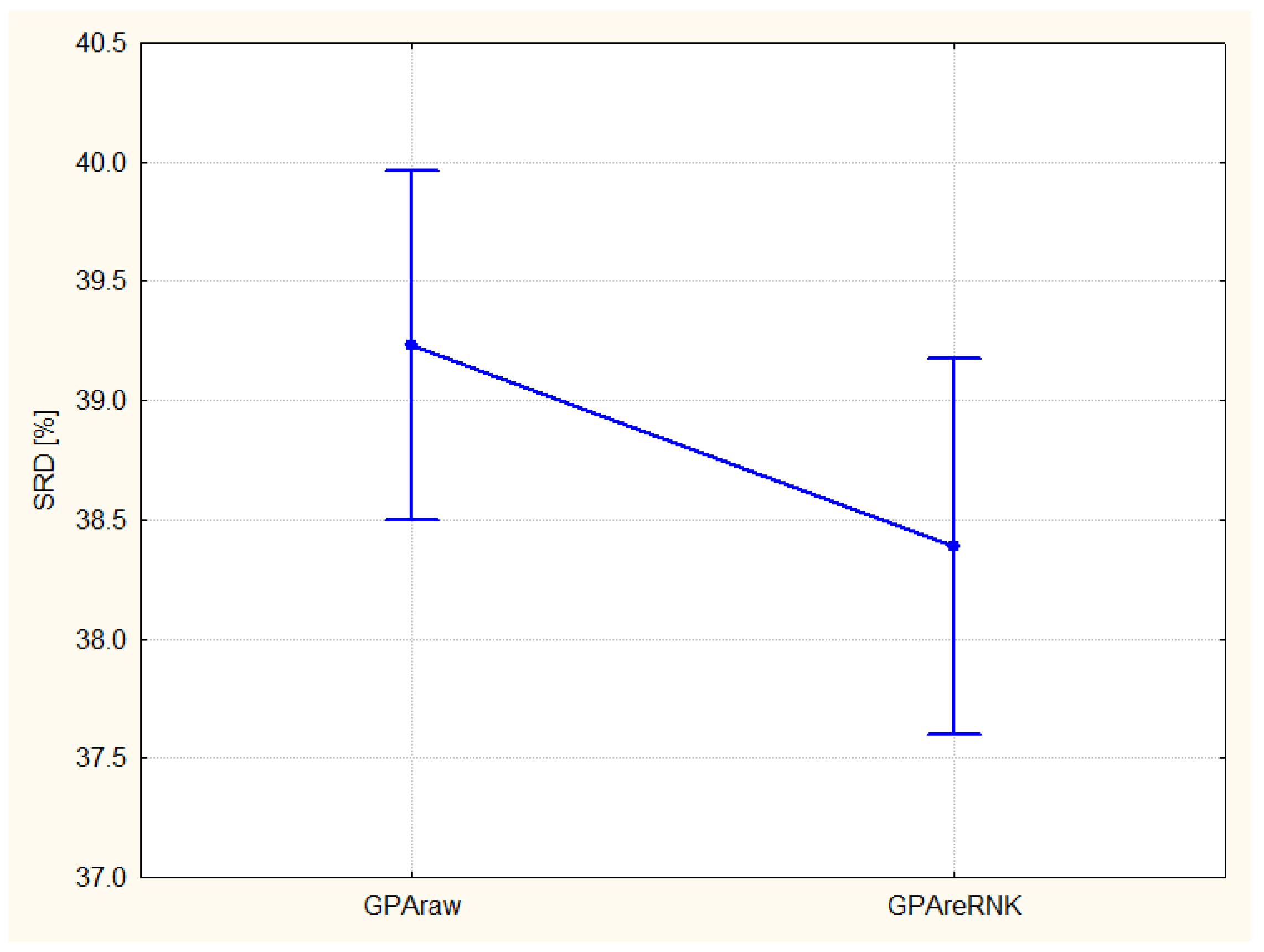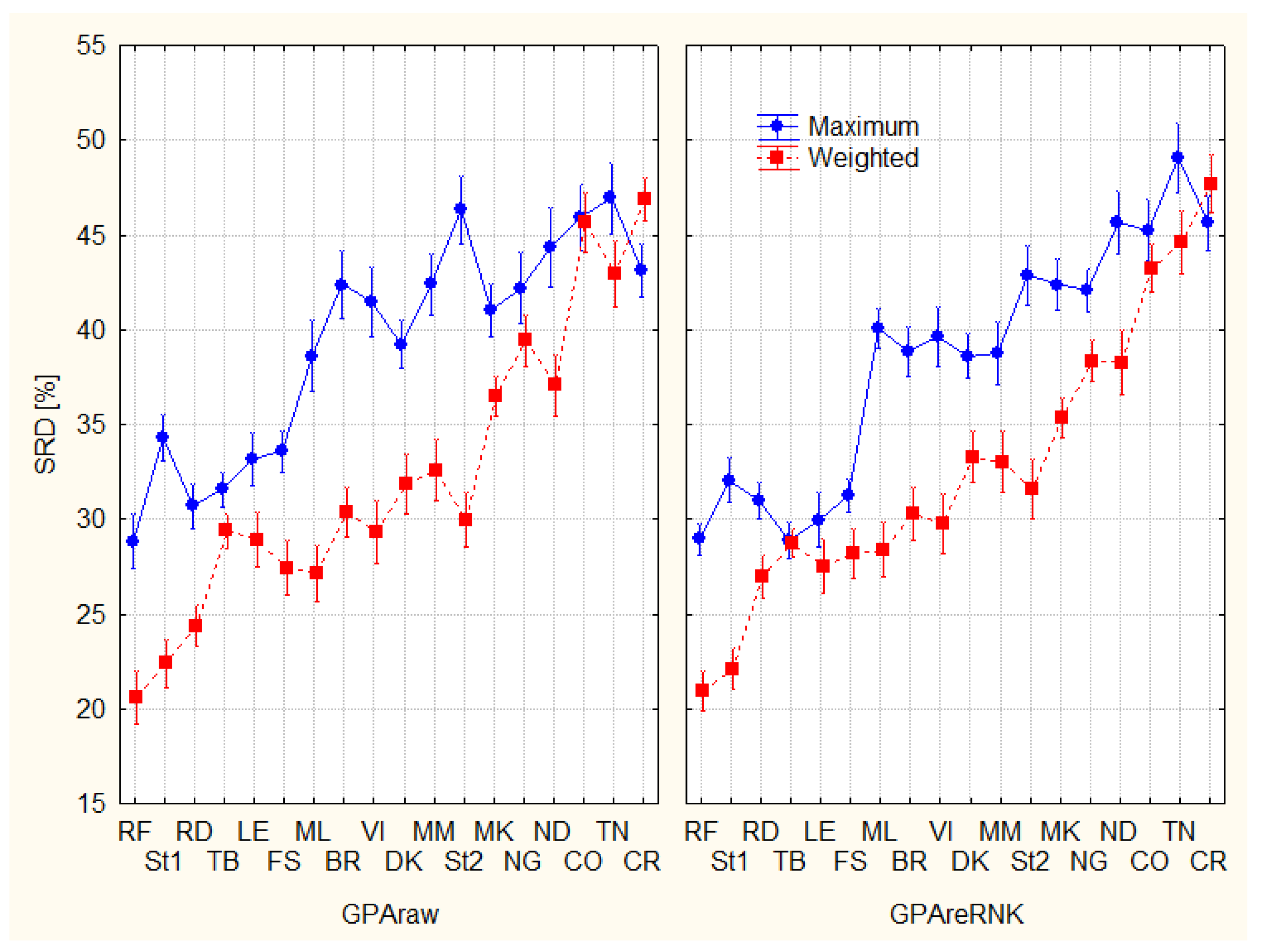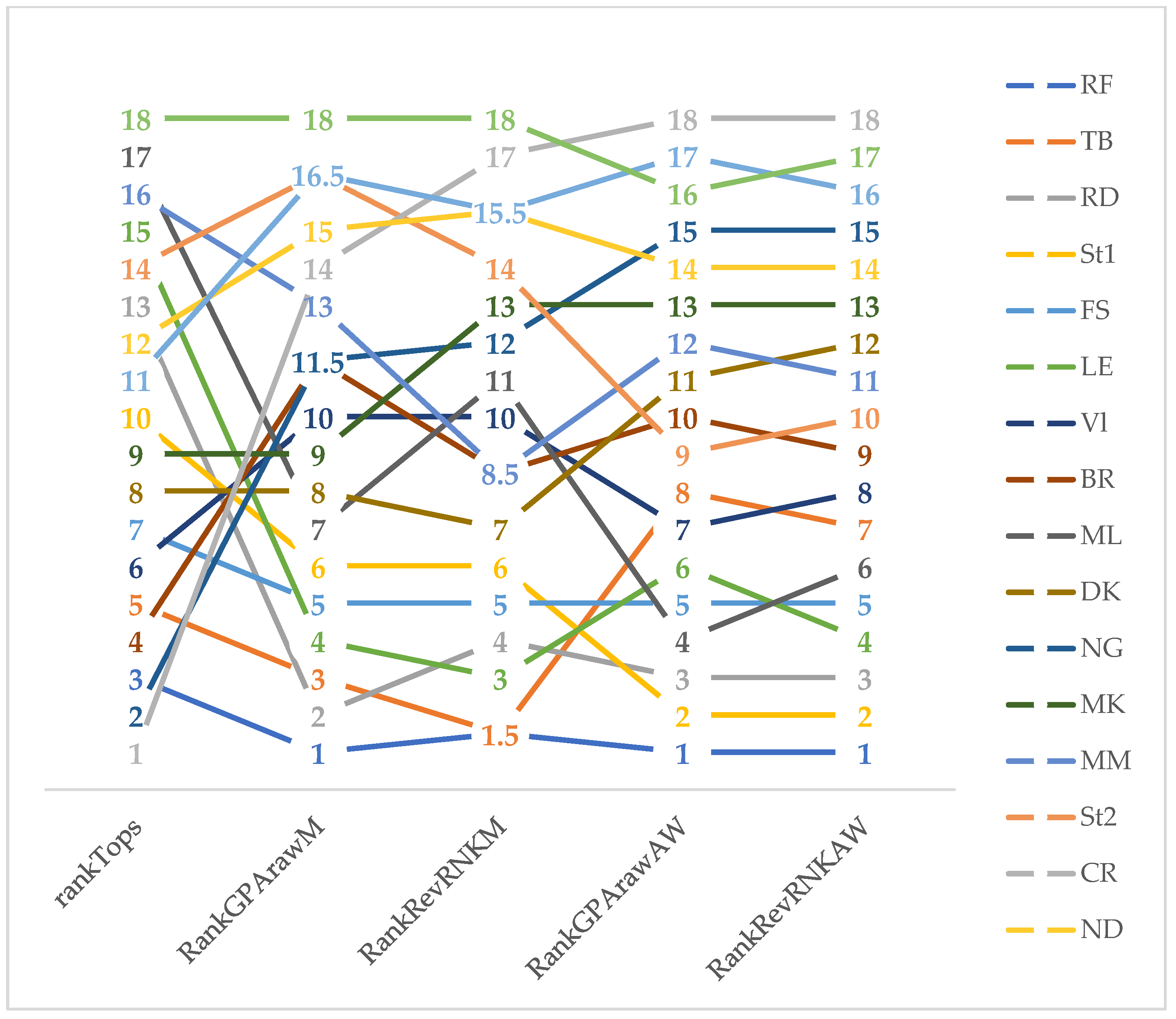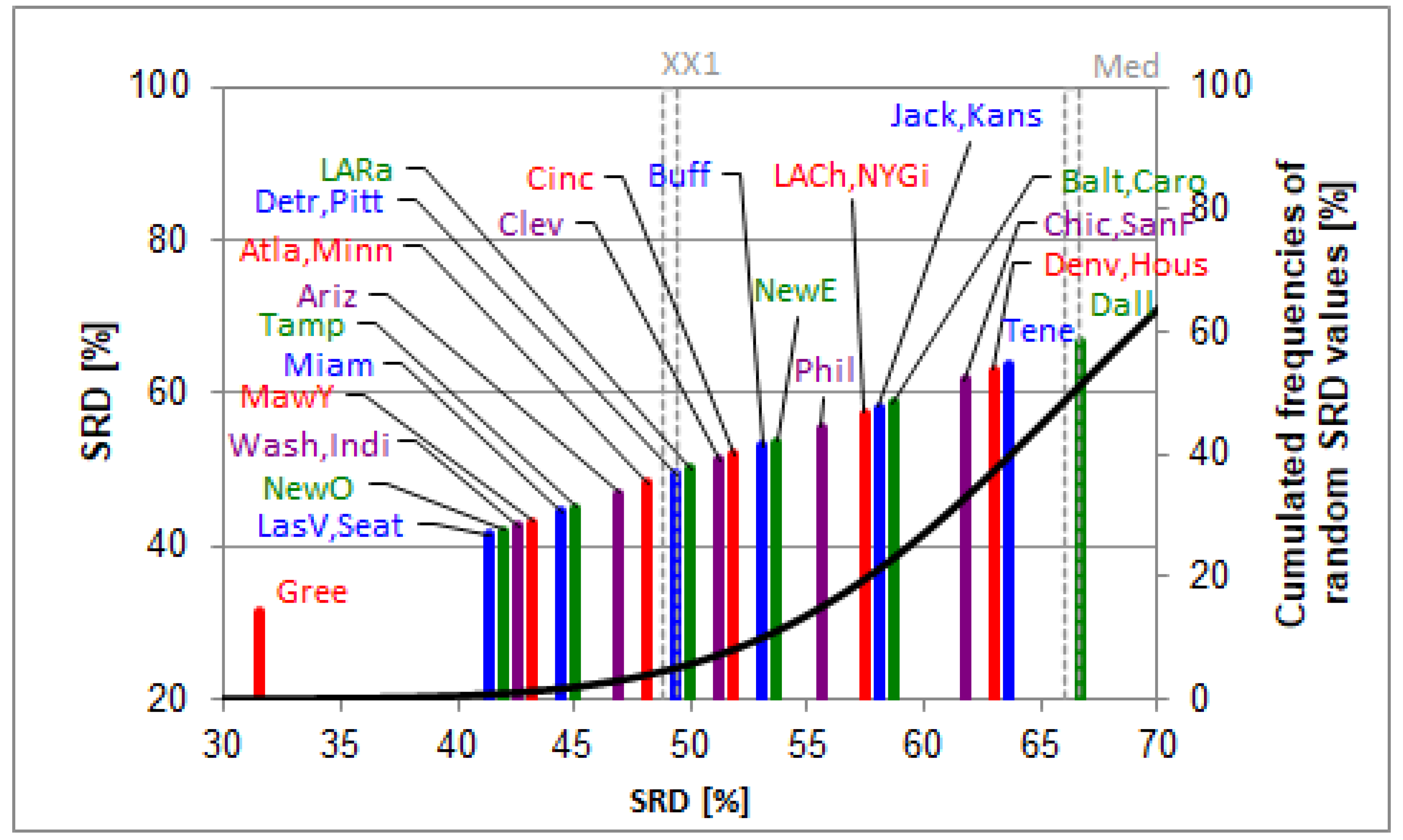Multiobject Optimization of National Football League Drafts: Comparison of Teams and Experts
Abstract
:Featured Application
Abstract
1. Introduction
2. Materials and Methods
2.1. Data Set
2.2. Sum of Ranking Differences
2.2.1. Evaluation of Experts
2.2.2. Evaluation of Teams
2.2.3. Coding of Data
3. Results
3.1. Evaluation of Experts
3.2. Evaluation of Teams
4. Discussion
- (i)
- Naturally, the results depend on the golden standard and the results will necessarily be changed if changing the benchmark. All variables (objectives) are used as a benchmark once and only once to resolve the benchmark ambiguity problem [15]. It was termed as COVAT (Comparisons with One Variable at a Time). A heatmap format was introduced to visualize the pairwise Manhattan distances (SRDs) [15].
- (ii)
- If the criteria are not conflicting, then the same ranking appears for each objective and no ordering takes place. However, it is a rare occasion, it happens only in the case of linearly dependent objectives.
- (iii)
- Different scales might lead to somewhat different ranking and grouping of the objectives. In such cases, more scaling options are advised to reach general conclusions; preferably, standardization, rank transformation, range scaling between 0 and 1, and normalization to unit length.
- (iv)
- The SRD computer codes do not allow weighting in their present version, though some decision makers would insist the favorable usage of preferred alternatives (criteria). This deficiency can easily be solved if we use a weighted standard as we have shown this possibility above cf. Figure 5 and the preceding corresponding text.
- (v)
- If the number of rows in the input matrix (the number of alternatives) is too small (say, below seven), then the probability of random ranking is enhanced though the most probable ordering outcome. If the number of rows surpasses 1400, then the fifth percentile of the randomization test provides a lower limit (conservative estimation). In practice, such a limitation is not a real one, as fully random ordering of 1400 items rarely happens, if at all.
5. Conclusions
Author Contributions
Funding
Institutional Review Board Statement
Informed Consent Statement
Data Availability Statement
Acknowledgments
Conflicts of Interest
References
- Wolfson, J.; Addona, V.; Schmicker, R.H. The quarterback prediction problem: Forecasting the performance of college quarterbacks selected in the NFL draft. J. Quant. Anal. Sports 2011, 7, 12. [Google Scholar] [CrossRef] [Green Version]
- Mulholland, J.; Jensen, S.T. Predicting the draft and career success of tight ends in the National Football League. J. Quant. Anal. Sports 2014, 10, 381–396. [Google Scholar] [CrossRef] [Green Version]
- Becker, A.; Sun, X.A. An analytical approach for fantasy football draft and lineup management. J. Quant. Anal. Sports 2016, 12, 17–30. [Google Scholar] [CrossRef] [Green Version]
- Héberger, K.; Kollár-Hunek, K. Sum of ranking differences for method discrimination and its validation: Comparison of ranks with random numbers. J. Chemom. 2011, 25, 151–158. [Google Scholar] [CrossRef]
- Kollár-Hunek, K.; Héberger, K. Method and model comparison by sum of ranking differences in cases of repeated observations (ties). Chemom. Intell. Lab. Syst. 2013, 127, 139–146. [Google Scholar] [CrossRef]
- Rácz, A.; Bajusz, D.; Héberger, K. Consistency of QSAR models: Correct split of training and test sets, ranking of models and performance parameters. SAR QSAR Environ. Res. 2015, 26, 683–700. [Google Scholar] [CrossRef] [Green Version]
- Lourenço, J.M.; Lebensztajn, L. Post-Pareto Optimality Analysis with Sum of Ranking Differences. IEEE Trans. Magn. 2018, 54, 1–10. [Google Scholar] [CrossRef]
- Héberger, K.; Kollár-Hunek, K. Comparison of validation variants by sum of ranking differences and ANOVA. J. Chemom. 2019, 33, e3104. [Google Scholar] [CrossRef] [Green Version]
- Hastie, T.; Tibshirani, R.; Friedman, J.H. Cross-Validation. In Elements of Statistical Learning. Data Mining, Inference, Prediction; Springer: New York, NY, USA, 2009; Volume 764, p. 243. [Google Scholar]
- Gere, A.; Héberger, K.; Kovács, S. How to predict choice using eye-movements data? Food Res. Int. 2021, 143, 110309. [Google Scholar] [CrossRef]
- Gere, A.; Rácz, A.; Bajusz, D.; Héberger, K. Multicriteria decision making for evergreen problems in food science by sum of ranking differences. Food Chem. 2021, 344, 128617. [Google Scholar] [CrossRef]
- Héberger, K. Sum of ranking differences compares methods or models fairly. TrAC Trends Anal. Chem. 2010, 29, 101–109. [Google Scholar] [CrossRef]
- Nowik, W.; Héron, S.; Bonose, M.; Tchapla, A. Separation system suitability (3S): A new criterion of chromatogram classification in HPLC based on cross-evaluation of separation capacity/peak symmetry and its application to complex mixtures of anthraquinones. Analyst 2013, 138, 5801–5810. [Google Scholar] [CrossRef] [PubMed]
- Grisoni, F.; Cassotti, M.; Todeschini, R. Reshaped Sequential Replacement for variable selection in QSPR: Comparison with other reference methods. J. Chemom. 2014, 28, 249–259. [Google Scholar] [CrossRef]
- Andric, F.; Bajusz, D.; Racz, A.; Segan, S.; Heberger, K. Multivariate assessment of lipophilicity scales-computational and reversed phase thin-layer chromatographic indices. J. Pharm. Biomed. Anal. 2016, 127, 81–93. [Google Scholar] [CrossRef] [Green Version]
- Odovic, J.; Markovic, B.; Vladimirov, S.; Karljikovic-Rajic, K. Evaluation of Angiotensin-Converting Enzyme Inhibitor’s Absorption with Retention Data of Micellar Thin-Layer Chromatography and Suitable Molecular Descriptor. J. Chromatogr. Sci. 2015, 53, 1780–1785. [Google Scholar] [CrossRef] [Green Version]
- Gere, A.; Radványi, D.; Héberger, K. Which insect species can best be proposed for human consumption? Innov. Food Sci. Emerg. Technol. 2019, 52, 358–367. [Google Scholar] [CrossRef] [Green Version]
- Brownfield, B.; Kalivas, J.H. Consensus Outlier Detection Using Sum of Ranking Differences of Common and New Outlier Measures Without Tuning Parameter Selections. Anal. Chem. 2017, 89, 5087–5094. [Google Scholar] [CrossRef]
- Kovačević, S.; Karadžić, M.; Podunavac-Kuzmanović, S.; Jevrić, L. Binding affinity toward human prion protein of some anti-prion compounds—Assessment based on QSAR modeling, molecular docking and non-parametric ranking. Eur. J. Pharm. Sci. 2018, 111, 215–225. [Google Scholar] [CrossRef]
- Li, W.; Miao, W.; Cui, J.; Fang, C.; Su, S.; Li, H.; Hu, L.; Lu, Y.; Chen, G. Efficient Corrections for DFT Noncovalent Interactions Based on Ensemble Learning Models. J. Chem. Inf. Model. 2019, 59, 1849–1857. [Google Scholar] [CrossRef]
- Chen, X.; Xu, Y.; Meng, L.; Chen, X.; Yuan, L.; Cai, Q.; Shi, W.; Huang, G. Non-parametric partial least squares–discriminant analysis model based on sum of ranking difference algorithm for tea grade identification using electronic tongue data. Sens. Actuators B Chem. 2020, 311, 127924. [Google Scholar] [CrossRef]
- Miranda-Quintana, R.A.; Bajusz, D.; Rácz, A.; Héberger, K. Extended similarity indices: The benefits of comparing more than two objects simultaneously. Part 1: Theory and characteristics. J. Cheminform. 2021, 13, 32. [Google Scholar] [CrossRef] [PubMed]
- West, C. Statistics for Analysts Who Hate Statistics, Part VII: Sum of Ranking Differences (SRD). LC-GC N. Am. 2018, 36, 882–885. [Google Scholar]
- Herrera-Viedma, E.; Herrera, F.; Chiclana, F. A consensus model for multiperson decision making with different preference structures. IEEE Trans. Syst. Man Cybern. Part A Syst. Hum. 2002, 32, 394–402. [Google Scholar] [CrossRef]
- Boccard, J.; Rutledge, D.N. A consensus orthogonal partial least squares discriminant analysis (OPLS-DA) strategy for multiblock Omics data fusion. Anal. Chim. Acta 2013, 769, 30–39. [Google Scholar] [CrossRef] [PubMed]
- Mansouri, K.; Ringsted, T.; Ballabio, D.; Todeschini, R.; Consonni, V. Quantitative Structure–Activity Relationship Models for Ready Biodegradability of Chemicals. J. Chem. Inf. Model. 2013, 53, 867–878. [Google Scholar] [CrossRef] [PubMed]
- Olson, D.L. Comparison of weights in TOPSIS models. Math. Comput. Model. 2004, 40, 721–727. [Google Scholar] [CrossRef]
- Vavrek, R. Evaluation of the Impact of Selected Weighting Methods on the Results of the TOPSIS Technique. Int. J. Inf. Technol. Decis. Mak. 2019, 18, 1821–1843. [Google Scholar] [CrossRef]
- Wang, T.-C.; Lee, H.-D. Developing a fuzzy TOPSIS approach based on subjective weights and objective weights. Expert Syst. Appl. 2009, 36, 8980–8985. [Google Scholar] [CrossRef]
- Csató, L. Ranking by pairwise comparisons for Swiss-system tournaments. Cent. Eur. J. Oper. Res. 2013, 21, 783–803. [Google Scholar] [CrossRef] [Green Version]
- Dadelo, S.; Turskis, Z.; Zavadskas, E.K.; Dadeliene, R. Multi-criteria assessment and ranking system of sport team formation based on objective-measured values of criteria set. Expert Syst. Appl. 2014, 41, 6106–6113. [Google Scholar] [CrossRef]
- Chen, C.; Lin, M.; Lee, Y.; Chen, T.; Huang, C. Selection best starting pitcher of the Chinese professional baseball league in 2010 using AHP and TOPSIS methods. In Frontiers in Computer Education, Advances in Intelligent and Soft Computing; Sambath, S., Zhu, E., Eds.; Springer: Berlin/Heidelberg, Germany, 2012; Volume 133, pp. 643–649. ISBN 9783642275517. [Google Scholar]
- Sinuany-Stern, Z. Ranking of sports teams via the ahp. J. Oper. Res. Soc. 1988, 39, 661–667. [Google Scholar] [CrossRef]
- Wang, C.N.; Tsai, H.T.; Nguyen, V.T.; Nguyen, V.T.; Huang, Y.F. A hybrid fuzzy analytic hierarchy process and the technique for order of preference by similarity to ideal solution supplier evaluation and selection in the food processing industry. Symmetry 2020, 12, 211. [Google Scholar] [CrossRef] [Green Version]
- Ortega, J.; Tóth, J.; Moslem, S.; Péter, T.; Duleba, S. An Integrated Approach of Analytic Hierarchy Process and Triangular Fuzzy Sets for Analyzing the Park-and-Ride Facility Location Problem. Symmetry 2020, 12, 1225. [Google Scholar] [CrossRef]
- Kaczynska, A.; Kołodziejczyk, J.; Sałabun, W. A new multi-criteria model for ranking chess players. Procedia Comput. Sci. 2021, 192, 4290–4299. [Google Scholar] [CrossRef]
- Angulo, E.; Romero, F.P.; López-Gómez, J.A. A comparison of different soft-computing techniques for the evaluation of handball goalkeepers. Soft Comput. 2021, 26, 3045–3058. [Google Scholar] [CrossRef]
- Nasiri, M.M.; Ranjbar, M.; Tavana, M.; Santos Arteaga, F.J.; Yazdanparast, R. A novel hybrid method for selecting soccer players during the transfer season. Expert Syst. 2019, 36, e12342. [Google Scholar] [CrossRef] [Green Version]
- Martínez, J.A.; Martínez, L. A stakeholder assessment of basketball player evaluation metrics. J. Hum. Sport Exerc. 2011, 6, 153–183. [Google Scholar] [CrossRef] [Green Version]
- Hochbaum, D.S.; Levin, A. Methodologies and algorithms for group-rankings decision. Manag. Sci. 2006, 52, 1394–1408. [Google Scholar] [CrossRef]
- Sziklai, B.R.; Biró, P.; Csató, L. The efficacy of tournament designs. Comput. Oper. Res. 2022, 144, 105821. [Google Scholar] [CrossRef]
- García-Ceberino, J.M.; Antúnez, A.; Ibáñez, S.J.; Feu, S. Design and Validation of the Instrument for the Measurement of Learning and Performance in Football. Int. J. Environ. Res. Public Health 2020, 17, 4629. [Google Scholar] [CrossRef]
- Dick, U.; Link, D.; Brefeld, U. Who can receive the pass? A computational model for quantifying availability in soccer. Data Min. Knowl. Discov. 2022, 36, 987–1014. [Google Scholar] [CrossRef]








| Coding of Experts | Coding of Teams | ||||
|---|---|---|---|---|---|
| 1 | CR | Chad Reuter | 1 | Chic | Chicago Bears |
| 2 | RF | Ryan Fowler | 2 | Clev | Cleveland Browns |
| 3 | NG | Nick Goss | 3 | LACh | Los Angeles Chargers |
| 4 | BR | Ben Rofle | 4 | MawY | New York Jets |
| 5 | VI | Vinnie Iyler | 5 | Miam | Miami Dolphins |
| 6 | TB | Tim Bielik | 6 | NewE | New England Patriots |
| 7 | DK | Danny Kelly | 7 | Balt | Baltimore Ravens |
| 8 | FS | Farrar & Schofield | 8 | Detr | Detroit Lions |
| 9 | St1 | Staff#1 | 9 | Jack | Jacksonville Jaguars |
| 10 | ND | Nate Davis | 10 | NYGi | New York Giants |
| 11 | MK | Mel Kiper Jr | 11 | Denv | Denver Broncos |
| 12 | RD | Ryan Dunleavy | 12 | Atla | Atlanta Falcons |
| 13 | CO | Conor Orr | 13 | Minn | Minnesota Vikings |
| 14 | St2 | Staff#2 | 14 | Kans | Kansas City Chiefs |
| 15 | ML | Matt Lombardo | 15 | Caro | Carolina Panthers |
| 16 | MM | Mark Maske | 16 | SanF | San Fransisco49ers |
| 17 | LE | Luke Easterling | 17 | Phil | Philadelphia Eagles |
| 18 | TN | Thor Nystrom | 18 | Wash | Washington Football Team |
| 19 | Tene | Tennessee Titans | |||
| 20 | Cinc | Cincinnati Bengals | |||
| 21 | Buff | Buffalo Bills | |||
| 22 | Tamp | Tampa Bay Buccaneers | |||
| 23 | Ariz | Arizona Cardinals | |||
| 24 | Pitt | Pittsburgh Steelers | |||
| 25 | Indi | Indianapolis Colts | |||
| 26 | Gree | Green Bay Packers | |||
| 27 | Dall | Dallas Cowboys | |||
| 28 | NewO | New Orleans Saints | |||
| 29 | LasV | Las Vegas Raiders | |||
| 30 | LARa | Los Angeles Rams | |||
| 31 | Seat | Seattle Seahawks | |||
| 32 | Hous | Houston Texans | |||
Publisher’s Note: MDPI stays neutral with regard to jurisdictional claims in published maps and institutional affiliations. |
© 2022 by the authors. Licensee MDPI, Basel, Switzerland. This article is an open access article distributed under the terms and conditions of the Creative Commons Attribution (CC BY) license (https://creativecommons.org/licenses/by/4.0/).
Share and Cite
Gere, A.; Szakál, D.; Héberger, K. Multiobject Optimization of National Football League Drafts: Comparison of Teams and Experts. Appl. Sci. 2022, 12, 6303. https://doi.org/10.3390/app12136303
Gere A, Szakál D, Héberger K. Multiobject Optimization of National Football League Drafts: Comparison of Teams and Experts. Applied Sciences. 2022; 12(13):6303. https://doi.org/10.3390/app12136303
Chicago/Turabian StyleGere, Attila, Dorina Szakál, and Károly Héberger. 2022. "Multiobject Optimization of National Football League Drafts: Comparison of Teams and Experts" Applied Sciences 12, no. 13: 6303. https://doi.org/10.3390/app12136303







